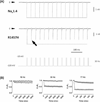Defective fast inactivation recovery of Nav 1.4 in congenital myasthenic syndrome
- PMID: 25707578
- PMCID: PMC4510994
- DOI: 10.1002/ana.24389
Defective fast inactivation recovery of Nav 1.4 in congenital myasthenic syndrome
Abstract
Objective: To describe the unique phenotype and genetic findings in a 57-year-old female with a rare form of congenital myasthenic syndrome (CMS) associated with longstanding muscle fatigability, and to investigate the underlying pathophysiology.
Methods: We used whole-cell voltage clamping to compare the biophysical parameters of wild-type and Arg1457His-mutant Nav 1.4.
Results: Clinical and neurophysiological evaluation revealed features consistent with CMS. Sequencing of candidate genes indicated no abnormalities. However, analysis of SCN4A, the gene encoding the skeletal muscle sodium channel Nav 1.4, revealed a homozygous mutation predicting an arginine-to-histidine substitution at position 1457 (Arg1457His), which maps to the channel's voltage sensor, specifically D4/S4. Whole-cell patch clamp studies revealed that the mutant required longer hyperpolarization to recover from fast inactivation, which produced a profound use-dependent current attenuation not seen in the wild type. The mutant channel also had a marked hyperpolarizing shift in its voltage dependence of inactivation as well as slowed inactivation kinetics.
Interpretation: We conclude that Arg1457His compromises muscle fiber excitability. The mutant fast-inactivates with significantly less depolarization, and it recovers only after extended hyperpolarization. The resulting enhancement in its use dependence reduces channel availability, which explains the patient's muscle fatigability. Arg1457His offers molecular insight into a rare form of CMS precipitated by sodium channel inactivation defects. Given this channel's involvement in other muscle disorders such as paramyotonia congenita and hyperkalemic periodic paralysis, our study exemplifies how variations within the same gene can give rise to multiple distinct dysfunctions and phenotypes, revealing residues important in basic channel function.
© 2015 American Neurological Association.
Conflict of interest statement
Nothing to report.
Figures






References
-
- Beeson D. Synaptic dysfunction in congenital myasthenic syndromes. Ann N Y Acad Sci. 2012;1275:63–69. - PubMed
-
- Slater CR. Structural factors influencing the efficacy of neuromuscular transmission. Ann N Y Acad Sci. 2008;1132:1–12. - PubMed
-
- Ruff RL, Lennon VA. End-plate voltage-gated sodium channels are lost in clinical and experimental myasthenia gravis. Ann Neurol. 1998;43:370–379. - PubMed
Publication types
MeSH terms
Substances
Grants and funding
LinkOut - more resources
Full Text Sources
Other Literature Sources
Molecular Biology Databases

